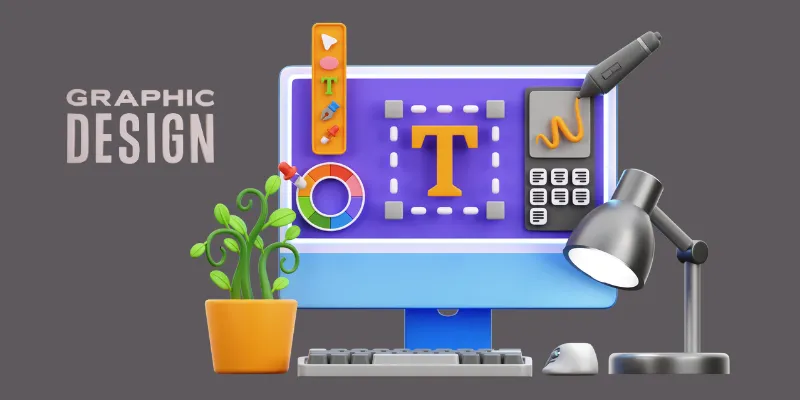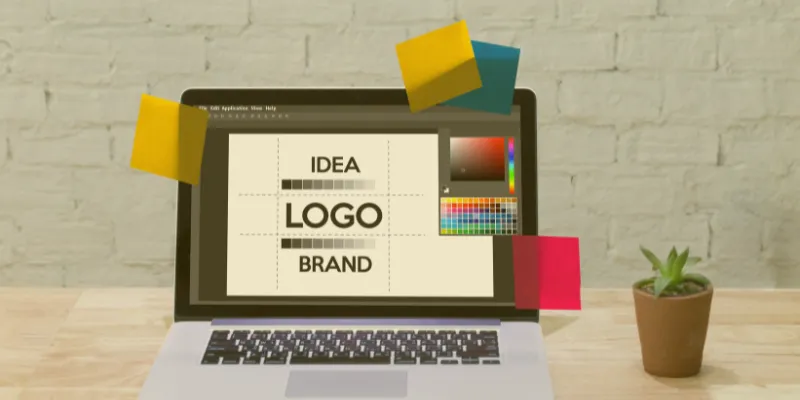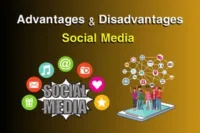Top 20 Advantages and Disadvantages of Graphic Design in Business
Published: 10 Aug 2025
Graphic design is the art of using colors, shapes, text, and images to share ideas visually. It helps people understand messages more quickly and retain them for a longer period. In today’s world, design plays a key role in business, personal branding, and social media. A good design can make a brand stand out and connect with its audience.
From a simple logo to a website layout, every visual detail shapes how people see a brand. In this guide, we will explore the benefits of graphic design for different purposes. We will also discuss the disadvantages so you can make informed decisions. By the end, you will understand how design can benefit you and where its limitations may lie.
Understanding Graphic Design
Graphic design is the art of creating visual content to share a message. In simple terms, it’s how we use shapes, colors, text, and images to make ideas easy to understand and more attractive. Graphic design for a company logo, flyer, or social media post helps information stand out and connect with people.

Main Elements of Graphic Design
- Color – Colors set the mood and feeling of a design. For example, blue feels calm, red feels energetic, and green feels fresh.
- Typography – This is the style of text. The font size, shape, and arrangement can make words look modern, classic, playful, or serious.
- Layout – This is how all the elements (text, images, shapes) are arranged. A good layout makes the design easy to read and pleasing to the eye.
- Imagery – Pictures, illustrations, icons, and graphics that make the design more engaging and help tell a story visually.
Common Uses of Graphic Design
- Logos – To create a strong brand identity.
- Advertisements – From billboards to online banners, to grab attention and promote products.
- Websites – To make the online experience visually appealing and easy to navigate.
- Social Media Posts – To stand out in a busy feed and communicate quickly with visuals.
Traditional vs. Digital Graphic Design
In the past, graphic design was mostly for print, like posters, magazines, and packaging. This is traditional graphic design. Today, most designs are made for digital platforms—like websites, apps, and social media. This is digital graphic design. While the tools and media have changed, the core principles of good design remain the same.
10 Advantages of Graphic Design
Graphic design is more than just making things look good, it is about communicating ideas effectively. The pros of graphic design can help businesses grow, build trust, and stand out in a competitive market.
1. Enhances Brand Identity
A strong brand identity starts with great design. From logos to color schemes, design shapes how people see your company. As a professional graphic designer, I know that consistent visuals make your business look trustworthy and memorable. When customers recognize your style instantly, you’re already winning the branding game.
- Custom logo design that reflects your brand values.
- Consistent colors, fonts, and imagery across all platforms.
- Professional branding graphics that build trust and recognition.

2. Grabs Attention Quickly
In today’s fast-scrolling world, you have just a few seconds to grab attention. Effective graphic design utilizes color, typography, and layout to capture people’s attention. Eye-catching visuals can make your ad stand out even in a crowded social media marketing.
- Bold, vibrant designs that stop scrolling instantly.
- Clear focal points for quick message delivery.
- Attractive ad creatives for Facebook, Instagram, and Google Ads.
3. Communicates Messages Effectively
Graphic design is a universal language that works without words. Whether it’s an infographic, brochure, or website banner, visuals help explain complex ideas quickly. Good design makes your message clear, simple, and appealing to your audience.
- Infographics that turn data into engaging stories.
- Icons and visuals that simplify complicated topics.
- Branded presentation slides that speak volumes without clutter.
4. Boosts Marketing & Sales
Well-designed marketing materials directly influence buying decisions. Professionally made flyers, social media posts, and product packaging attract more customers. A design that’s both beautiful and strategic helps drive more clicks, inquiries, and purchases.
- Attractive product packaging that stands out on shelves.
- Click-worthy social media designs for higher engagement.
- Creative promotional banners for online and offline sales.
5. Improves User Experience
User experience is not just about functionality, it is about visual comfort too. A well-designed website, app, or dashboard makes it easy for people to navigate and take action. Great UI/UX design keeps visitors engaged and reduces bounce rates.
- Clean layouts for smooth website navigation.
- Clear call-to-action buttons that increase conversions.
- Mobile-friendly designs for better accessibility.
6. Increases Professional Credibility
Poor design can make even the best business look unprofessional. High-quality graphics show that you care about details. When customers see professional design, they automatically trust your services or products more.
- Professional business cards that leave a strong impression.
- Elegant brochure designs for corporate presentations.
- Branded proposal templates that impress clients.
7. Supports Storytelling
Every brand has a story, and visuals make it unforgettable. From Instagram carousels to product videos, design helps tell your journey in a way that words alone can not. As a designer, I use visuals to bring emotions and narratives to life.
- Story-driven social media content that builds connections.
- Product photography layouts that tell a brand story.
- Creative mood boards to capture the brand’s personality.
8. Versatility Across Platforms
A good design works everywhere—whether it’s a billboard, website banner, or Instagram post. As a graphic designer, I ensure designs adapt perfectly to every medium without losing impact.
- Print-ready designs for flyers, posters, and magazines.
- Digital graphics optimized for web and mobile.
- Social media templates for consistent branding across platforms.
9. Helps Stand Out from Competition
In competitive markets, a unique design is your secret weapon. Custom graphics make you memorable and position you as different from the rest. Creative visuals give people a reason to choose you over others.
- Unique brand illustrations instead of stock images.
- Custom typography that makes your brand voice stronger.
- One-of-a-kind packaging designs that pop on shelves.
10. Encourages Emotional Connection
Colors, shapes, and imagery have a direct impact on emotions. A professional graphic designer knows how to create visuals that connect with customers on a deeper level. This emotional bond often leads to brand loyalty.
- Warm, inviting designs for hospitality and lifestyle brands.
- Bold, exciting visuals for sports and entertainment.
- Soft, calming color palettes for health and wellness industries.
10 Disadvantages of Graphic Design
While graphic design offers many creative opportunities, it also comes with specific challenges. In this section, we will explore the 10 cons of graphic design so you can prepare and overcome them effectively.
1. Time-Consuming – Quality Design Requires Patience
Great design isn’t made in a rush. The creative process takes research, brainstorming, concept creation, and revisions. While this ensures a polished, professional look, it can be time-intensive compared to quick templates.
- Detailed research and brainstorming slow down delivery.
- Revisions and client feedback loops extend deadlines.
- Complex tools and design techniques require extra hours.

2. Can Be Expensive – Professional Designers & Tools Cost Money
High-quality design often needs skilled designers, premium software, and powerful hardware. While this investment boosts brand image, it’s not always budget-friendly for startups.
- Professional design services have higher fees.
- Software like Adobe Creative Cloud comes with monthly costs.
- High-end computers and accessories are needed for smooth work.
3. Subjective Feedback – Different People May Dislike the Same Design
Design is art plus communication, which means everyone sees it differently. What’s “beautiful” for one person might not appeal to another, leading to endless revisions.
- Clients’ personal preferences may clash with design principles.
- Feedback often focuses on style over purpose.
- Too many opinions can dilute the original creative vision.
4. Constant Learning Needed – Trends & Tools Change Fast
Graphic design is never static. Design trends, software updates, and creative strategies evolve quickly. So designers must keep learning to stay competitive.
- New tools like AI design apps require constant up-skilling.
- Design trends change every year, impacting style choices.
- Continuous learning adds extra time to a designer’s schedule.
5. Copyright Issues – Risk of Using Unlicensed Content
Using stock images, fonts, or graphics without proper licensing can lead to legal trouble. While originality is key, it’s easy to overlook copyright restrictions.
- Risk of copyright infringement without license checks.
- Stock assets often have usage limits.
- Original content creation takes more time and resources.
6. Technical Limitations – Software & Hardware Requirements
Even the best creative ideas need the right tools to bring them to life. Slow computers, outdated software, or missing features can block creativity.
- Heavy design files can crash low-performance systems.
- Some software features require premium upgrades.
- Compatibility issues between design tools cause delays.
7. Overemphasis on Looks – Style Over Substance Can Backfire
While visual appeal is vital, focusing only on “pretty” design without clear messaging or usability can harm brand goals.
- Beautiful designs that fail to communicate the message.
- Prioritizing aesthetics over functionality in UI/UX design.
- Misleading visuals can confuse or frustrate the audience.
8. Creative Burnout – Pressure to Always Be Original
Designers often face constant pressure for fresh, unique ideas. Over time, this can lead to mental fatigue and creative block.
- Tight deadlines reduce creative breathing space.
- Repetitive projects drain inspiration.
- Fear of “copying” others makes ideation stressful.
9. Miscommunication with Clients
Sometimes, clients and designers speak different creative languages. Without clear communication, expectations and results may not match.
- Ambiguous project briefs lead to wrong concepts.
- Clients may change direction midway.
- Lack of visual references causes misunderstandings.
10. Not Always Measurable ROI
Design adds long-term brand value, but its exact financial return is tricky to measure compared to direct marketing campaigns.
- The sales impact of design is often indirect.
- Difficult to prove value without analytics.
- ROI depends on other business factors, not design alone.
How to Maximize the Benefits & Reduce the Drawbacks
As a professional graphic designer, I’ve learned that the real magic lies in balancing creativity with smart work habits. If you are a beginner or already practicing, here’s how you can enjoy the perks of graphic design while avoiding common pitfalls.
1. Start with Free or Affordable Tools
You don’t need expensive software at the start. Tools like Canva, Figma, and Photopea offer powerful features without heavy costs. Once you grow and earn from your work, you can invest in premium tools like Adobe Creative Cloud.
2. Keep Learning Through Tutorials & Practice
Graphic design trends change fast. Dedicate time every week to watch tutorials, read design blogs, or try new techniques. Practice daily, even if it’s just creating a small social media post or redesigning a flyer.
3. Use Templates to Save Time
Templates are not cheating, they are time-savers. Customize them with your style to maintain originality while meeting deadlines. This is especially useful when working on multiple projects.
4. Follow Design Trends But Adapt Them
Trends keep your designs fresh, but blindly copying them can make your work look generic. Take inspiration from trends, then add your creative twist so your designs stand out.
5. Communicate Clearly with Clients or Stakeholders
Many design issues come from misunderstandings. Always clarify project goals, brand guidelines, and deadlines before starting. Share drafts early for feedback to avoid last-minute revisions.
Common Mistakes to Avoid in Graphic Design
When learning graphic design, it’s easy to make mistakes that can hurt your work and your professional reputation. Let’s look at some common ones and how to avoid them.
1. Overusing Colors & Fonts
Many beginners think that more colors and fancy fonts will make their design stand out, but in reality, it can make it look messy.
2. Copying Designs Without Permission
It’s okay to take inspiration, but directly copying someone else’s work is both unethical and illegal.
3. Ignoring Target Audience Needs
Design is not about what you like — it’s about what your audience understands and connects with.
4. Designing Without a Clear Goal
A design without a purpose is like a road trip without a map; you might go somewhere, but not where you need to be.
Conclusion
Graphic design is a key skill for visually sharing ideas. It helps businesses, brands, and individuals connect with their target audience. Strong designs make messages clear and easy to understand. Good visuals also make content more attractive and memorable.
Anyone can learn graphic design with practice and patience. Start with small projects and explore different styles. Every step you take will build your creative confidence. Creativity is not a gift; it is a skill you can grow every day.
Common Queries
Creativity is important, but it is not the only skill you need in design. Many designers grow their creativity with daily practice and inspiration. Learning tools and techniques can help you create great work even if you start small.
Canva is an excellent choice for simple and quick design projects. Adobe Photoshop and Illustrator are also popular for professional-level work. Start with one program and slowly explore others as your skills grow.
Basic design skills can be learned in a few months with regular practice. Mastering advanced techniques often takes one to two years. The learning never stops because design trends keep changing.
Yes, many people work as full-time graphic designers in companies or agencies. You can also work as a freelancer and handle projects for different clients. With skill and dedication, it can become a stable and rewarding career.

- Be Respectful
- Stay Relevant
- Stay Positive
- True Feedback
- Encourage Discussion
- Avoid Spamming
- No Fake News
- Don't Copy-Paste
- No Personal Attacks

- Be Respectful
- Stay Relevant
- Stay Positive
- True Feedback
- Encourage Discussion
- Avoid Spamming
- No Fake News
- Don't Copy-Paste
- No Personal Attacks





